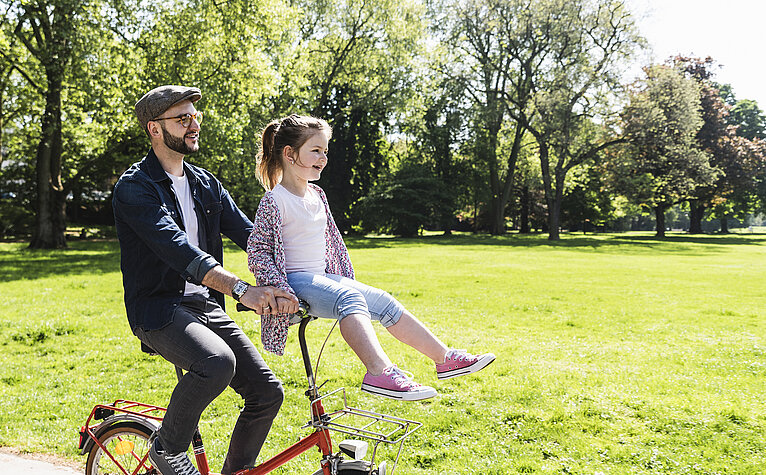
- Living in Austria
Austria’s School System: What Parents Should Know
21. November 2022If you relocate to Austria with your children, you will probably have several questions concerning the education of your child. Austria attaches great importance to education. Back in 1774, Empress Maria Theresia already introduced compulsory schooling (“Schulpflicht”). However, a lot has happened since then. The educational facilities in the country, whether they are public or private, maintain high standards. In this article you will find out more about the many schools in Austria. Continue reading to find out what the various school models have to offer.
Compulsory Education in Austria
All children residing in Austria, including children of parents who are living in Austria with a residence permit, are required to attend school up until the age of 14. Please note that compulsory schooling lasts for nine years and begins in the year in which the child has turned six years old before 31 August.
Primary School (Elementary School)
After the time spent in kindergarten or the pre-school year, children usually begin attending primary school (“Volksschule”) at the age of six. Schools impart basic knowledge and skills to children over a period of four years (up until the age of 10). Here you can learn more about primary schools in Austria. primary schools in Austria. ()
Lower Secondary Education
After attending primary school for four years, children are given the choice of deciding which path they will follow and which school they would like to attend in the future.
After primary school, there are a large number of public and private schools in Austria with varying educational priorities. Austria has about 1,200 public secondary schools and 72 private schools which are supported by the government.
Pupils can conclude their lower secondary education i.e., 5th-8th grades, also called the lower grades or lower cycle (“Unterstufe”) either at a lower secondary school (“Mittelschule - MS”), also known as a compulsory secondary school, or at an academic secondary or grammar school (“Allgemeinbildenden Höheren Schule – AHS”).
The core subjects taught in secondary school are mathematics, natural sciences, classical languages and foreign languages. Depending on the educational focus of the particular school, emphasis is also placed on sports, music or creativity.
Secondary schools operate similarly to primary schools. This means lessons begin starting on the first Monday in September and classes are held on five days per week. The school year in secondary schools consists of two semesters, which are interrupted in the course of the year by certain holidays.
What types of secondary schools are there in Austria?
Once a child has completed his or her primary school education, the child switches to a lower secondary school. The two types of public secondary schools (AHS and MS) begin in the 5th grade and last until the end of the 8th grade. Here you will find out what you need to know about both types of schools in Austria.
Lower Secondary School (“Mittelschule” - MS)
The lower secondary school is a compulsory Austrian public secondary school for pupils in grades 5-8. In contrast to an academic secondary school (AHS), a lower secondary school must accept all pupils who completed the fourth year of primary school with positive marks. The lower secondary school prepares its pupils for professional or vocational training later on, and offers instruction which is tailored to the interests, abilities and skills of the pupils. Starting in the third level, pupils can take advanced courses in German, mathematics and foreign languages. After concluding the lower secondary school, pupils have the option of either transferring to a college for higher vocational education or the upper level of an academic secondary school.
Academic Secondary School (“Gymnasium” – AHS)
The Austrian AHS system offers a comprehensive and broad general education. The German term “Gymnasium” normally encompasses all academic secondary schools (grammar schools). The AHS includes a four-year, lower-level education for the 5th-8th grades (classes 1-4) and a four-year upper-level education for the 9th-12th grades (classes 5-8). All pupils in grades 5 and 6 have the same general curriculum. Starting in the 7th grade (3rd level), the AHS focuses on preparing the pupils for a certain type of university education.
Please note that the AHS is not required to accept certain pupils if their performance at school does not meet the specified standards. After successfully completing the 5th class of an AHS, a pupil is no longer obliged to continue his or her education, although most pupils actually do continue. During their education in an AHS, pupils can concentrate on the following areas:
Classic Academic Secondary School (“Gymnasium”)
This educational path in the Austrian academic secondary school is designed to help pupils develop critical thinking. The focus is on liberal arts, humanities and learning different languages such as English, Latin and French. This means:
- learn at least two foreign languages.
- get an education which is specifically oriented to giving them the university entrance qualification.
- pupil with a secondary school leaving certificate (“Matura”) is entitled to study at universities and universities of applied sciences in Austria. (Please note that some universities hold entrance examinations.)
Academic Secondary School Emphasizing Economics (“Wirtschaftskundliches Realgymnasium”)
This educational path strongly focuses on business, economic and technical skills as well as on textile crafts. This means:
- learn to solve problems.
- are given valuable skills they can apply in the working world.
Academic Secondary School Emphasizing Mathematics and Science (“Realgymnasium”)
Similar to the academic secondary school emphasizing economics, the academic school emphasizing mathematics and science teaches technical and textile crafts. In contrast to the academic secondary school emphasizing economics, the focus of this form is on mathematics, natural sciences and geometry. Pupils also learn practical skills in addition to traditional academic subjects.
Note that an AHS can decline to accept certain students if their academic performance does not meet certain standards. Additionally, after successful completion of Year 9 in an AHS, education stops being compulsory, though most students continue. They can focus on one of the below areas during their time in an AHS.
Gymnasium
The Gymnasium strand of Austrian secondary school helps students develop stronger critical thinking skills. It focuses on liberal arts, humanities, and teaching students different languages such as English, Latin, and French.
- Students will learn at least two foreign languages
- Students will receive an education intentionally, directly focused on college prep.
- Any student with a Gymnasium “Matura” diploma must be accepted into an Austrian university
Wirtschaftskundliches Realgymnasium
This strand puts a strong emphasis on business, economics, and technical skills, as well as textile handwork.
- Students will learn how to problem solve
- They’ll finish with valuable skills they can take into the workforce
Realgymnasium
As with Wirtschaftskundliches Realgymnasium, students on the Realgymnasium track study technical and textile handwork. Unlike Wirtschaftskundliches Realgymnasium, the Realgymnasium strand also focuses on maths, science, and geometry. They’ll learn practical skills alongside traditional academics.
Musisches Gymnasium
Musisches Gymnasium students focus on fine arts such as music, dance, literature, and drama. They may also study rhetoric.
- Encourages students to tap into their creative abilities
- Supports a unique curriculum based in culture
Sportgymnasium
In many ways, a Sportgymnasium AHS resembles a traditional grammar school. Its distinguishing factor is a focus on sports.
- Increases students ability to new skills
- High academic performance
Special forms
In Austria there are special forms of an AHS education, e.g., specialising in sports or music, and which correspondingly promote these skills. Another example are the academic secondary schools in the western part of Austria which place particular emphasis on promoting particularly young and talented skiers.
Higher-Level Vocational Secondary Schools (“Berufsbildende höhere Schulen - BHS”) and Schools for Intermediate Vocational Education (“Berufsbildende mittlere Schulen – BMS”)
After completing the lower level of a secondary school, pupil can choose among a large selection of higher-level vocational secondary schools and schools for intermediate vocational education. The education at higher-level vocational secondary schools, also known as colleges for higher vocational education, lasts for five years (9th-13th grades, classes 1-5). This type of education is concluded with a school-leaving examination (“Reifeprüfung” or “Matura”) or a diploma examination (“Diplomprüfung”). Moreover, these schools also provide vocational training in a certain area. In this way, graduates can directly enter a certain profession.
There are also other kinds of higher-level vocational secondary schools, for example:
- Higher Federal Technical College (“Höhere technische und gewerbliche Lehranstalt”)
- Higher Educational Institution for Fashion (“Höhere Lehranstalt für Mode”)
- Higher Educational Institution for Artistic Design (“Höhere Lehranstalt für künstlerische Gestaltung”)
- Higher Educational Institution for Product Management and Presentation (“Höhere Lehranstalt für Produktmanagement und Präsentation”)
- Higher Educational Institution for Tourism (“Höhere Lehranstalt für Tourismus”)
- Commercial Academy (“Handelsakademie”): training for senior positions in business and public administration
- Higher Educational Institution for Economic Professions (“Höhere Lehranstalt für wirtschaftliche Berufe”): training for work in tourism, social and economic professions.
- Higher Educational Institute for Nursing and Social Care (“Höhere Lehranstalt für Pflege und Sozialbetreuung”): training for work in the fields of nursing and social care
- Higher Educational Institution for Agriculture and Forestry (“Höhere Lehranstalt für Land- und Forstwirtschaft”): training for qualified skilled workers in agriculture, viticulture and horticulture, food and biotechnology etc.
- Educational Institution for Early Childhood Education (“Bildungsanstalt für Elementarpädagogik”): training for work in early education fields such as kindergartens, day care centres, nursery schools, etc.
- Educational Institution for Social Education (“Bildungsanstalt für Sozialpädagogik”): training for work in old people’s homes, day care centres, etc.
Schools for Intermediate Vocational Education (“Berufsbildende mittlere Schulen”)
This type of education can last between one and four years (ages 14-18). In this case schools also have different educational priorities. These schools are concluded with professional examinations (“Fachprüfungen”) and entitle the pupils to directly enter the related professions:
- Secondary Technical, Commercial and Crafts School (“Technische, gewerbliche und kunstgewerbliche Fachschulen”) lasting three or four years
- Secondary Business School (“Handelsschule”) for three years: training for all professions in business and public administration
- Vocational School for Economic Professions (“Fachschule für wirtschaftliche Berufe”) for one, two or three years): training for professions in business and tourism as well as vocational preparation
- Vocational School for Fashion (“Fachschule für Mode”) lasting three years
- Vocational School for the Hotel and Restaurant Industry (“Hotelfachschule, Gastgewerbefachschule”) for three years: training as a skilled worker in hotels and catering as well as tourism
- Schools for Social Professions:
- Three-year Vocational School for Social Professions (“Fachschule für Sozialberufe”) at several locations including care assistant (one additional semester)
- Vocational Schools for Social Care Professions (“Schulen für Sozialbetreuungsberufe”) - admission to studies starting at the ages of 17-19) with the following focus areas: working for the elderly, working with families, working with people with disabilities, accompanying persons with disabilities; studies concluded at a professional level based on 2-3 years of schooling (“Fachniveau”) or with a diploma (“Diplomniveau”) based on 3-4.5 years of school; also for employed persons.
- Vocational Schools for Agriculture and Forestry (“Land- und forstwirtschaftliche Fachschulen“) for two to four years
- Vocational Schools for Pedagogical Assistant Professions (“Fachschulen für pädagogische Assistenzberufe”) lasting three years: training as an assistant in educational tasks in early childhood facilities
- Vocational Schools for Healthcare and Nursing: training in vocational schools in cooperation with clinics and hospitals as of 2024
Polytechnical school
This one-year education is offered after the 8th year of school. Pupils are prepared for their professional work or apprenticeship and can choose among various specialized fields.
Vocational school
After completing the compulsory nine years of education, young people can also choose an apprenticeship occupation. The apprentices are directly given practical, hands-on training by the companies. The pupils acquire theoretical knowledge in the vocational school, spending certain days at school and the remaining time in the companies where they are trained. This approach applies to different fields and lasts for up to four years, depending on the apprenticeship occupation. The vocational school is concluded by taking the final apprenticeship examination.
Other Types of Schools
Private secondary schools in Austria
There are more than 600 private schools in Austria. About 10% of all Austrian secondary school pupils attend a private school. Similar to the public schools, there are several types of private schools, including the ones described below. Private schools include many denominational schools where religion often plays a major role in the curriculum. Pupils in private schools conclude their school years with typical degrees, for example the school-leaving examination.
There are also special forms of private secondary schools in Austria, for example Waldorf schools (based on teaching methods propagated by Rudolf Steiner) or Montessori schools.
International secondary schools
International secondary schools in Austria offer pupils a multicultural environment and an outstanding education. Pupils can attend either an American, British or French international school. In this way children whose families relocate to Austria from abroad can continue their education with the same approach to learning which they are accustomed to.
- language of instruction which your child already knows
- similar learning structure to his/her native country
- multicultural environment
How much does school cost in Austria?
Attending public schools in Austria does not cost anything for the compulsory school years. However, parents must pay for school outings and teaching materials.
How much does a private school in Austria cost?
Education in a private Austrian school can cost more than € 25,000 per year. As a rule, boarding schools are expensive and cost between € 30,000 and € 50,000 annually. These amounts only cover tuition. Additional fees may be charged for enrolment, registration, food and accommodations and more.
How to enrol in an Austrian school
The process of enrolling in secondary schools can vary, depending on the type of school.
- normally select a school nearby and directly register their children online.
- process requires parents to submit documents about the child and the child’s resume, as well as:
- school marks
- of the child’s passport
- requested, recommendations from previous teachers
- the parents have submitted all the required forms, the school will probably ask for a personal meeting with the family.
If you want to apply to an Austrian secondary school on behalf of your child, you should always do this early on. The most popular secondary schools often attract a great deal of interest so that a waiting list is unavoidable.
As soon as your child has been accepted by a school, the only thing left to do is to fill out the registration forms. These forms are easy to fill out but can be long and tedious. Frequently many forms must be filled out.
Learn more about Austria
Whether you’re moving to Austria for a career or just to start a new chapter, there’s plenty to learn about your new home! Explore our resourcesExplore our resources () to learn everything you and your kids should know about life in Austria and your future here.
More blog posts





